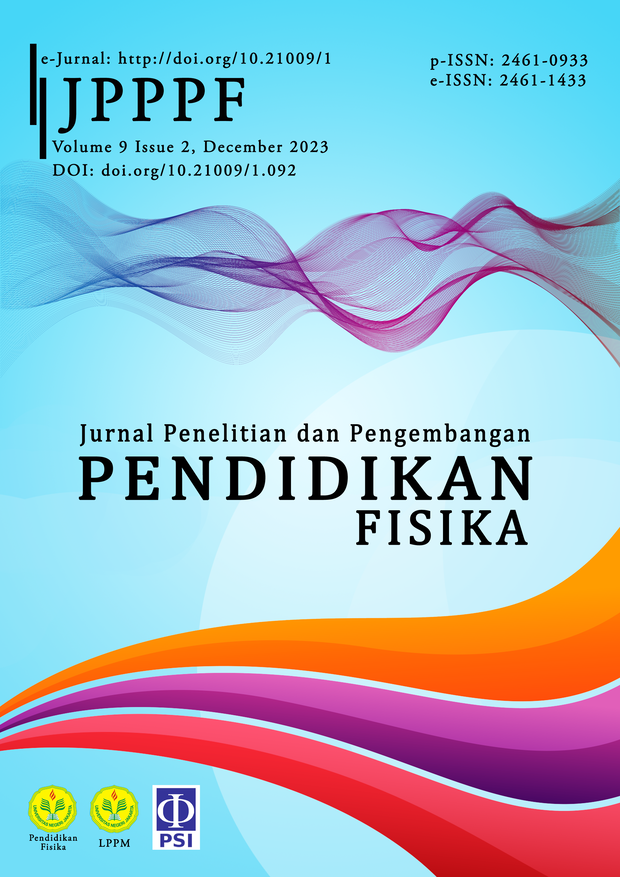Development of a Two-Tier Diagnostic Test for The Analysis of Momentum and Impulse Learning Difficulties in Students
DOI:
https://doi.org/10.21009/1.09206Keywords:
diagnostic test, formative test, impulse and momentum, two tierAbstract
This study aimed to develop a formation test that also serves as a diagnostic test. The purpose of this product is to determine students’ learning difficulty levels. We used a two-step multiple-choice assessment tool to develop this diagnostic test. Because two-step multiple-choice tests help teachers identify learning difficulties that arise in students. The research method used is research and development. This test was developed using the Moodle platform and takes the form of a closed multiple-choice test consisting of 20 questions. Media and materials experts validate diagnostic tests. Based on validation, this developed product can be used as a physics learning assessment tool to measure student learning outcomes and learning difficulties. The aspects of media learning expert is usability, navigation, visuals, product, effectiveness, and content. While, the aspects of material expert are compliance with curriculum, construction, and language. We tested high school students and found that 2 of the 20 questions about the concepts of momentum and impulse were mastered and the remaining 18 were at the level of instrumental understanding and misunderstanding. Therefore, teachers should look for strategies to expand students' conceptual knowledge of dynamics and momentum. Thus, the mastery of the student's concept is whole and thorough.
References
Bezanilla, MJ, Fernández-Nogueira, D, Poblete, M & Galindo-Domínguez, H 2019, ‘Methodologies for teaching-learning critical thinking in higher education: The teacher’s view’, Thinking skills and creativity, vol. 33, p. 100584, https://doi.org/10.1016/j.tsc.2019.100584.
Choi, Y & McClenen, C 2020, ‘Development of adaptive formative assessment system using computerized adaptive testing and dynamic bayesian networks’, Applied Sciences, vol. 10, no. 22, p. 8196, https://doi.org/10.3390/app10228196.
Dawati, FM, Yamtinah, S, Rahardjo, SB, Ashadi, A & Indriyanti, NY 2019, ‘Analysis of students’ difficulties in chemical bonding based on computerized two-tier multiple choice (CTTMC) test’, Journal of Physics: Conference Series, vol. 1157, no. 4, p. 042017, https://doi.org/10.1088/1742-6596/1157/4/042017.
Fadzil, HM, Saat, RM & Rafi, A 2022, ‘Development of Technology-Enhanced Three-Tier Diagnostic Test to Assess Pre-university Students’ Understanding of Scientific Concepts’, Alternative Assessments in Malaysian Higher Education: Voices from the Field, Singapore: Springer Singapore, pp. 285-292, https://doi.org/10.1007/978-981-16-7228-6_29.
Ivanjek, L, Morris, L, Schubatzky, T, Hopf, M, Burde, JP, Haagen-Schützenhöfer, C et al. 2021, ‘Development of a two-tier instrument on simple electric circuits’, Physical Review Physics Education Research, vol. 17, https://doi.org/10.1103/PhysRevPhysEducRes.17.020123.
Klieger, A & Goldsmith, L 2019, ‘Expanding physics learning beyond classroom boundaries-a case study’, Physics Education, vol. 55, no. 2, p. 025004, http://dx.doi.org/10.1088/1361-6552/ab5d68.
Mutoharoh, M & Ambarwulan, D 2021, ‘Evaluation of the use of the Moodle Platform for Fundamental Physics Lectures at University’, Jurnal Penelitian & Pengembangan Pendidikan Fisika, vol. 7, no. 2, pp. 169-176, https://doi.org/10.21009/1.07209.
Pahlawan, R 2021, ‘Developing an Interactive Digital Handout for Momentum and Impulse Material Physics in High School’, Journal of Education Technology, vol. 5, no. 1, pp. 137-144, https://doi.org/10.23887/jet.v5i1.31719.
Permana, AH, Sekartaji, A & Ambarwulan, D 2022, ‘Development of Diagnostic Test of Learning Difficulties for High School on Newton’s Law Material using Moodle Learning Platform’, Journal of Physics: Conference Series, vol. 2377, no. 1, p. 012070, https://doi.org/10.1088/1742-6596/2377/1/012070.
Poondej, C & Lerdpornkulrat, T 2020, ‘Gamification in e-learning: A Moodle implementation and its effect on student engagement and performance’, Interactive Technology and Smart Education, vol. 17, no. 1, pp. 56-66, https://ir.swu.ac.th/jspui/handle/123456789/12205.
Putranta, H 2019, ‘Synthesis of the cognitive aspects’ science literacy and higher order thinking skills HOTS in chapter momentum and impulse’, Journal of Physics: Conference Series, vol. 1397, no. 1, p. 012014, https://doi.org/10.1088/1742-6596/1397/1/012014.
Rintayati, P, Lukitasari, H & Syawaludin, A 2021, ‘Development of Two-Tier Multiple Choice Test to Assess Indonesian Elementary Students' Higher-Order Thinking Skills’, International Journal of Instruction, vol. 14, no. 1, pp. 555-566, http://dx.doi.org/10.29333/iji.2021.14133a.
Shin, J, Chen, F, Lu, C & Bulut, O 2022, ‘Analyzing students’ performance in computerized formative assessments to optimize teachers’ test administration decisions using deep learning frameworks’, Journal of Computers in Education, vol. 9, no. 1, pp. 71-91, https://doi.org/10.1007/s40692-021-00196-7.
Swenson, J, Beranger, K & Johnson, AW 2022, ‘How students take up open-ended, real world problems’, IEEE Frontiers in Education Conference FIE, pp. 1-5, https://doi.org/10.1109/FIE49875.2021.9637362.
Syarlisjiswan, MR & Wahyuningsih, D 2021, ‘The development of e-modules using Kodular software with problem-based learning models in momentum and impulse material’, Journal of Physics: Conference Series, vol. 1796, no. 1, p. 012078, https://doi.org/10.1088/1742-6596/1796/1/012078.
Thiagarajan, S 1974, ‘Instructional development for training teachers of exceptional children: A sourcebook’.
Timothy, V, Watzka, B, Stadler, M, Girwidz, R & Fischer, F 2023, ‘Fostering Preservice Teachers’ Diagnostic Competence in Identifying Students’ Misconceptions in Physics’, International Journal of Science and Mathematics Education, vol. 21, no. 5, pp. 1685-1702, https://doi.org/10.1007/s10763-022-10311-4.
Xu, T, Wu, X, Sun, S & Kong, Q 2023, ‘Cognitive Diagnostic Analysis of Students’ Mathematical Competency Based on DINA Model’, Psychology in the Schools, https://doi.org/10.1002/pits.22916.
Xu, W, Liu, Q, Koenig, K, Fritchman, J, Han, J, Pan, S & Bao, L 2020, ‘Assessment of knowledge integration in student learning of momentum. Physical Review Physics Education Research, vol. 16, no. 1, p. 010130, https://doi.org/10.1103/PhysRevPhysEducRes.18.020102.











